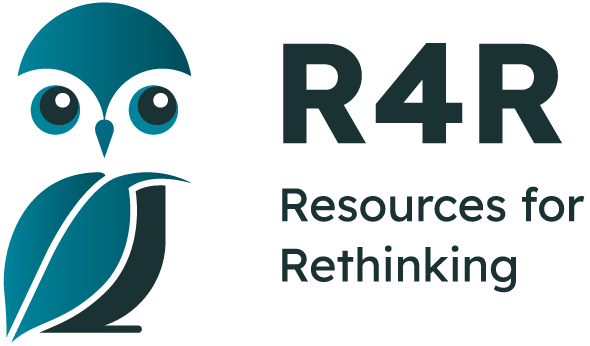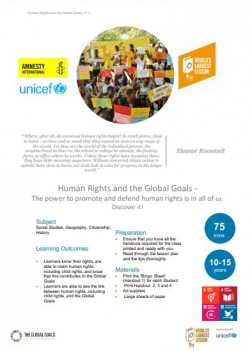- Home
- Tutorial
- Resource Guides
- Focus Areas
- LSF Programs
-
Professional
Development - Review Process
-
A project of LSF

Search for Resources
Description
This lesson plan will help assist young students in better understanding human rights. Students will discover their rights, will be able to claim human rights, including child rights, and will know that this contributes to the Global Goals.
The lesson is divided in 4 separate steps
Step 1: Human Rights Bingo- This activity will engage students into thinking about human rights and increase their curiosity towards them.
Step 2: The Learning Activity - During this activity students will work cooperatively to create an image that helps them define human rights.
Step 3: The Global Goals of Human Rights – This will help students understand and discover, either through video or posters, certain Global Goals (both are provided in the resource).
Step 4: Take Action – This section gives multiple ideas on how a class or individual can take action when looking at standing up for human rights.
General Assessment
What skills does this resource explicitly teach?
Young students are explicitly taught about their own rights as children. They are exposed to a few real life stories of other children in the world and their lack of human rights. Consensus-building by students is a large part of the activity in this resource.
Strengths
- This is a small and user-friendly lesson plan.
- The lesson plan has multiple links to help teachers better understand children’s rights.
Weaknesses
- No assessment tools are included in the resource.
- No attention is given to students with different ability levels
- In the last step- Take Action, the lesson plan has multiple suggestions, but does not explain how to put these ideas in motion
Relevant Curriculum Units
The following tool will allow you to explore the relevant curriculum matches for this resource. To start, select a province listed below.
- Step 1Select a province
- Alberta
- Step 2Select a grade level
- Grade 9
- Step 3Select a subject
- Social Studies
- Step 4Relevant matches
- Issues for Canadians: Governance and Rights
- Knowledge and Employability: Canada - Governance and Citizenship
- British Columbia
- Step 2Select a grade level
- Grade 5
- Step 3Select a subject
- Social Studies
- Step 4Relevant matches
- Canadian Issues and Governance: Canada’s policies and treatment of minority peoples have negative and positive legacies
- Grade 6
- Step 3Select a subject
- Social Studies
- Step 4Relevant matches
- Global Issues and Governance: Complex global problems require international cooperation to make difficult choices for the future.
- Grade 8
- Step 3Select a subject
- Social Studies
- Step 4Relevant matches
- 7th Century to 1750: Human and environmental factors shape changes in population and living standards.
- Manitoba
- Step 2Select a grade level
- Grade 7
- Step 3Select a subject
- Social Studies
- Step 4Relevant matches
- People & Places in the World: Global Quality of Life
- Grade 8
- Step 3Select a subject
- Social Studies
- Step 4Relevant matches
- World History: Socities of the Past -Understanding Societies Past and Present
- Grade 9
- Step 3Select a subject
- Social Studies
- Step 4Relevant matches
- Canada in the Contempoary World: Democracy and Governance in Canada
- Canada in the Contemporary World:Diversity and Pluralism in Canada
- Newfoundland & Labrador
- Step 2Select a grade level
- Grade 6
- Step 3Select a subject
- Social Studies
- Step 4Relevant matches
- World Issues
- Grade 9
- Step 3Select a subject
- Social Studies
- Step 4Relevant matches
- Canadian Identitity: Citizenship and Identity: What it Means to be Canadian
- Canadian Identity: Reflections on Canadian Identity: What it Means to be Canadian
- Canadian Identity:Exploring Canadian Identity
- Grade 10
- Step 3Select a subject
- Social Studies
- Step 4Relevant matches
- Social Studies 1201: Individual Rights and the Common Good
- Northwest Territories
- Step 2Select a grade level
- Grade 5
- Step 3Select a subject
- Social Studies
- Step 4Relevant matches
- Canadian Issues and Governance: Canada’s policies and treatment of minority peoples have negative and positive legacies
- Grade 6
- Step 3Select a subject
- Social Studies
- Step 4Relevant matches
- Global Issues and Governance: Complex global problems require international cooperation to make difficult choices for the future.
- Nova Scotia
- Step 2Select a grade level
- Grade 6
- Step 3Select a subject
- Social Studies
- Step 4Relevant matches
- Social Studies 6: World Issues
- Grade 8
- Step 3Select a subject
- Social Studies
- Step 4Relevant matches
- Social Studies 8 - A Changing Canadian Society: Societal Conflict
- Grade 9
- Step 3Select a subject
- Social Studies
- Step 4Relevant matches
- Citizenship 9: Engaged Citizenship
- Citizenship 9: Who Am I as a Citizen?
- Nunavut
- Step 2Select a grade level
- Grade 9
- Step 3Select a subject
- Social Studies
- Step 4Relevant matches
- Issues for Canadians: Governance and Rights
- Grade 10
- Step 3Select a subject
- Social Studies
- Step 4Relevant matches
- Citizenship in Canada
- Northern Studies: Our World Today
- Ontario
- Step 2Select a grade level
- Grade 8
- Step 3Select a subject
- History
- Step 4Relevant matches
- Canada, 1890-1914: A Changing Society
- Grade 10
- Step 3Select a subject
- Civic Studies
- Step 4Relevant matches
- Civics and Citizenship (Open): Civic Awareness
- Prince Edward Island
- Step 2Select a grade level
- Grade 6
- Step 3Select a subject
- Social Studies
- Step 4Relevant matches
- World Issues
- Grade 9
- Step 3Select a subject
- Social Studies
- Step 4Relevant matches
- Interdependence: Atlantic Canada in the Global Community: Citizenship in the Global Community
- Interdependence: Atlantic Canada in the Global Community: Human Rights in the Global Community
- Quebec
- Step 2Select a grade level
- Grade 8
- Step 3Select a subject
- History & Citizenship Education
- Step 4Relevant matches
- Winning of Civil Rights & Freedoms
- Saskatchewan
- Step 2Select a grade level
- Grade 8
- Step 3Select a subject
- Social Studies
- Step 4Relevant matches
- The Individual in Canadian Society: Interaction & Interdependence of Nations
- Grade 9
- Step 3Select a subject
- Social Studies
- Step 4Relevant matches
- The Roots of Society: Interdependence & Interaction
- Grade 10
- Step 3Select a subject
- History
- Step 4Relevant matches
- History 10: Political Decision Making
- Yukon Territory
- Step 2Select a grade level
- Grade 5
- Step 3Select a subject
- Social Studies
- Step 4Relevant matches
- Canadian Issues and Governance: Canada’s policies and treatment of minority peoples have negative and positive legacies
Themes Addressed
Human Rights (9)
- Cultural Diversity
- Education
- Gender Equality
- Poverty
- Refugees and Immigration
- Religious Diversity
- Sexual Diversity
- Social Justice
- War and Peace
Sustainability Education Principles
| Principle | Rating | Explanation |
|---|---|---|
| Consideration of Alternative Perspectives | Good | A variety of perspectives have been included in the resource. |
Consideration of Alternative Perspectives:
| ||
| Multiple Dimensions of Problems & Solutions | Satisfactory | There is an acknowledgement of the multiple dimensions of problems and solutions, although these are not deliberately addressed. |
| Multiple Dimensions of Problems & Solutions: Effectively addresses the environmental, economic and social dimensions of the issue(s) being explored.
| ||
| Respects Complexity | Good | Effectively done in an age appropriate manner |
| Respects Complexity: The complexity of the problems/issues being discussed is respected. | ||
| Acting on Learning | Good | The last step is entirely devoted to taking action. It suggests multiple ideas on how a class or individual can take action when looking at standing up for human rights. |
| Acting on Learning: Learning moves from understanding issues to working towards positive change — in personal lifestyle, in school, in the community, or for the planet
| ||
| Values Education | Good | In reading the summarized description of human rights, students can give discuss their own beliefs and values. |
| Values Education: Students are explicitly provided with opportunities to identify, clarify and express their own beliefs/values. | ||
| Empathy & Respect for Humans | Very Good | The various rights issues encompass a wide range of human groups. |
| Empathy & Respect for Humans: Empathy and respect are fostered for diverse groups of humans (including different genders, ethnic groups, sexual preferences, etc.). | ||
| Personal Affinity with Earth | Poor/Not considered | |
| Personal Affinity with Earth: Encourages a personal affinity with -the natural world.
| ||
| Locally-Focused Learning | Good | The resource is clear on the starting point for understanding human rights. |
| Locally-Focused Learning: Includes learning experiences that take advantage of issues/elements within the local community.
| ||
| Past, Present & Future | Good | |
| Past, Present & Future: Promotes an understanding of the past, a sense of the present, and a positive vision for the future. | ||
Pedagogical Approaches
| Principle | Rating | Explanation |
|---|---|---|
| Open-Ended Instruction | Very Good | Students are allowed to develop their own responses to questions. |
| Open-Ended Instruction
: Lessons are structured so that multiple/complex answers are possible; students are not steered toward one 'right' answer. | ||
| Integrated Learning | Satisfactory | The lesson essentially focuses on social studies outcomes. |
| Integrated Learning: Learning brings together content and skills from more than one subject area
| ||
| Inquiry Learning | Good | The activities are designed in a progressive learning style. |
| Inquiry Learning: Learning is directed by questions, problems, or challenges that students work to address.
| ||
| Differentiated Instruction | Satisfactory | The resources offers some visual and kinesthetic activities. |
| Differentiated Instruction: Activities address a range of student learning styles, abilities and readiness.
| ||
| Experiential Learning | Good | |
| Experiential Learning: Authentic learning experiences are provided
| ||
| Cooperative Learning | Good | Student work cooperatively in small and large group activities |
| Cooperative Learning: Group and cooperative learning strategies are a priority.
| ||
| Assessment & Evaluation | Poor/Not considered | The assessment strategies are not clearly defined. |
| Assessment & Evaluation: Tools are provided that help students and teachers to capture formative and summative information about students' learning and performance. These tools may include reflection questions, checklists, rubrics, etc. | ||
| Peer Teaching | Good | |
| Peer Teaching: Provides opportunities for students to actively present their knowledge and skills to peers and/or act as teachers and mentors.
| ||
| Case Studies | Good | A few case studies are used in step three. |
| Case Studies: Relevant case studies are included. Case studies are thorough descriptions of real events from real situations that students use to explore concepts in an authentic context. | ||
| Locus of Control | Good | Most of the content will be addressed through group work and class discussions, and as such, a great deal of consensus-building is required. |
| Locus of Control: Meaningful opportunities are provided for students to choose elements of program content, the medium in which they wish to work, and/or to go deeper into a chosen issue. | ||

